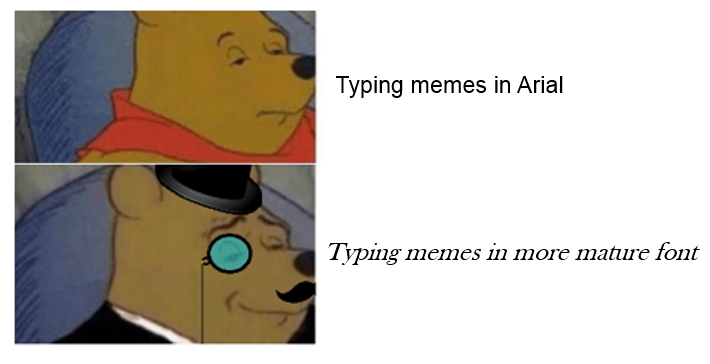May I Disclose in Times New Roman, 12-Point Font?
Written by Loran Jackson, Regulatory Compliance Counsel
Happy Friday, compliance friends!
As we are all painfully aware, there are many regulations that mandate specific disclosure requirements (disclosures are our favorite, right?). Among these regulations are NCUA’s advertising rule, Truth in Savings, and multiple portions of Regulation Z. Often, we get questions about font style and size requirements. In general, if a font style and size requirement exists, it may be found within the section or commentary that governs the content requirements of a particular disclosure. I will not discuss every instance of a font size or style requirement, so remember to double check the regulation if you believe a certain disclosure may have a font requirement.

NCUA’s Official Statements
Federally-insured credit unions are expected to use NCUA's official statement where it accepts deposits or opens accounts. For the statement required where the credit union accepts deposits or open accounts, section 740.4(b) includes a sample of what the sign should look like, but allows a credit union to vary the size of font to ensure legibility. Likewise, when using the official sign or other similar language in advertisements, the credit union may vary the font to ensure legibility.
Federally-insured credit unions are also required to use NCUA’s official advertising statement in all of its advertisements. The regulations allow these requirements to be satisfied with the same sign shown in 740.4(b). The regulation also gives a few text options for advertisements, so a credit union need not always choose the official sign. See, 12 C.F.R. §740.5(b)(1). When using one of the available text options, section 740.5(b)(2) explains that the advertising statement “must be in a size and print that is clearly legible and may be no smaller than the smallest font size used in other portions of the advertisement.” Therefore, a credit union may not create an advertisement that includes fonts ranging between sizes 10 and 14-point, with an advertising statement written in 9-point font. The advertising statement would have to be no smaller than the smallest font size used, 10-point font in this example.
Truth in Savings Disclosures
Section 707.3(a) of NCUA’s Truth in Savings rule requires credit unions to make certain account opening disclosures “clearly and conspicuously, in writing, in a form the member or potential member may keep.” The descriptor “clearly and conspicuously” is a popular one, but may have a different meaning depending on what regulation you are reading. For the general disclosures in Truth in Savings, the commentary states that credit unions are not required to use a particular type size or typeface, nor are credit unions required to state any term more conspicuously than any other term.
In addition to general disclosure rules, Truth in Savings contains advertising requirements in section 707.8. These rules do not create specific font size requirements, but focus on the goal that advertisements “must not be misleading or inaccurate.” For example, if a credit union advertises an annual percentage yield (APY) for a tiered-account, section 707.8(c) requires the credit union to state the APY associated with each tier, not just the highest possible yield. The rule does not require the APY for each tier to be in close proximity or with equal prominence to other APYs. However, for each APY, credit unions are required to state the minimum balance needed to earn that yield, and each minimum balance is required to be stated in close proximity and with equal prominence to the associated APY. See, 12 C.F.R. 707.8(c)(3).
Reg Z - Open-End Credit
In general, credit unions are required to make the disclosures required by Reg Z clearly and conspicuously. For open-end credit accounts in general, the commentary to section 1026.5(a) specifies a group of disclosures that are required to be provided in a minimum of 10-point font. These include:
· credit card applications and solicitations under §1026.60;
· highlighted account-opening disclosures under §1026.6(b)(1);
· highlighted disclosures on checks that access a credit card account under §1026.9(b)(3);
· highlighted change-in-terms disclosures under §1026.9(c)(2)(iv)(D); and
· highlighted disclosures when a rate is increased due to delinquency, default or penalty pricing under §1026.9(g)(3)(ii).
Additionally, sections 1026.6(b)(2)(i) and 1026.60(b) require both the premium initial rates on account-opening tables, and the APR on credit card applications and solicitations be provided in at least 16-point font. In reading the rules together, credit unions are required to have disclosures that include 10-point font for some information, while using 16-point font for certain rate information.
In looking at the open-end credit model forms, Appendix G samples use a “readable font style” (10-point Arial font style, except for the purchase annual percentage rate, which is shown in 16-point type). Although specific font sizes are required for certain disclosures, the style of Arial is not required. However, the Bureau encourages credit unions to consider these techniques when deciding how to disclose information to ensure that the information is presented in a readable format.
Reg Z - Closed-End Credit
In general, Reg Z does not mandate font type and size requirements for all closed-end credit disclosures. Commentary to section 1026.17(a) “requires that disclosures be in a reasonably understandable form.” However, for mortgage transactions, section 1026.18(s) requires the interest and payments summary to be in a minimum 10-point font. For certain mortgage loans, a credit union may offer an early estimate to give the borrower an idea of the costs of the loan. These estimates are governed by section 1026.19(e)(2)(ii) and require the credit union to “clearly and conspicuously state at the top of the front of the first page of the estimate in a font size that is no smaller than 12-point font: ‘Your actual rate, payment, and costs could be higher. Get an official Loan Estimate before choosing a loan.’” For both loan estimates and closing disclosures, the general rule applies that the font is required to be legible and provided in a readily understandable form.
Lastly, certain post-consummation events for mortgage loans are governed by section 1026.20, which describes various disclosures that are triggered by different events, such as agreement modification. For example, if an escrow account was established in connection with a mortgage transaction, and the escrow account will be cancelled, the credit union is required to clearly and conspicuously disclose certain terms in 1026.20(e)(2). The disclosures are required to be provided in a minimum 10-point font, grouped together on the front side of a one-page document, separate from all other materials, with the headings, content, order, and format substantially similar to Model Form H-29 in Appendix H.

